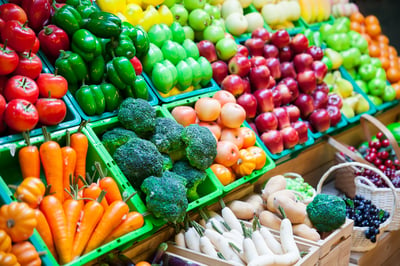The grocery business is facing an identity crisis. As the rising popularity of pick-up/delivery services and limited-selection format stores makes clear, customers prefer to spend as little time as possible shopping for groceries. The Food Marketing Institute and Nielsen now predict that within five to seven years, 70 percent of shoppers will buy their groceries online. 
This trend is countered by fresh-format stores, which have transformed the once-mundane grocery run into an enjoyable exploration. They offer prepared foods, wine bars, samples, cooking demonstrations, classes, and other upgrades tailored to individual shoppers’ tastes. One profitable example is the in-house juice bar — but is it right for your store? First, consider these four questions.
What are your current in-house drink offerings?
Already have a coffee bar? It’s an easy upgrade to add a commercial juicer and blender to the counter, then introduce an expanded menu. Just be sure that you choose the right equipment for the job.
Smoothies made from whole fresh fruit and other fibrous ingredients require a high-performance blender with a strong motor to drive the blade. A basic blender just won’t cut it. Commercial juicers can be more complicated, because every machine on the market has certain positives and negatives. We designed otto™ the Juice Extractor to be an affordable, super-durable machine for made-to-order juicing.
Who’s your audience?
Some consumers consider fresh juice to be part of their wellness routine. Others think of juice as a delicious mid-day refresher. If your shoppers are heavily into health, make sure your menu meets their expectations with drinks that include greens and functional ingredients. Choose a commercial juicer that can handle tough vegetables and fibrous greens, with a powerful motor and a basket that’s easy to clean.
Wheatgrass juice shots can be a profitable offering, because they’re easy to serve in a juice bar and tough to make at home. You’ll need a specialty juicer like the HWG800, an ultra-durable commercial wheatgrass juicer made with surgical stainless steel parts.
If customers lean more toward drinks that are sweet and/or indulgent, serve smoothies and refreshers, such as flavored lemonades and iced teas. See a lot of parents shopping with children? Fresh apple and orange juices will be a hit.
What are customers’ expectations for service speed?
In limited-selection grocery stores, shoppers’ main objective is to get what they need and leave as soon as possible. It follows that a juice bar serving made-to-order drinks isn’t a great fit. These smaller stores can consider serving freshly made, grab-and-go drinks from a cooler. Be aware that the shelf life of fresh juice is extremely short, so over-estimating demand can be costly.
In other grocery stores — like those with cafés, prepared-food bars and spaces to socialize — shoppers are inclined to linger. Here, made-to-order juices and smoothies will be a success, as long as staff and equipment can keep up with demand. Because employees are working with such a wide variety of ingredients, most juice bars find that they need more than one juicer to keep the drinks flowing. If one customer orders a juice with beets, for example, the next drinks will be pinkish in color until the strainer has been cleaned. If drinks with strong-tasting ingredients are on the menu, you’ll want to reserve one juicer for making those, so that no one gets garlic in their apple juice.
What are your business goals?
When it comes to juice-bar profit goals, grocery stores have a few advantages over stand-alone juicing operations:
- Foot traffic is a known quantity
- Peak demand times are easy to predict
- No additional costs to lease space
- Little need for marketing/promotion expenses
- Employees can be cross-trained in other store roles
The biggest advantage of all: groceries already have a cost-effective supply chain for fresh produce. The rule of thumb for juice bars is that the income from beverage sales should be at least double the cost of the ingredients, according to Poster POS. Grocery stores may even be able to reduce existing food-waste expenses by sending “ugly” fruits and vegetables to the juice bar, instead of throwing them out. From a customer perspective, this is a bonus (just look at the growth of companies like Imperfect Produce.)
Thinking about getting into the juicing business at your grocery store? ? See all of Hamilton Beach Commercial’s innovative solutions for adding juicing to grocery operations.


